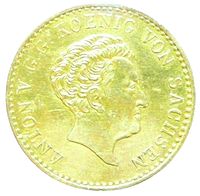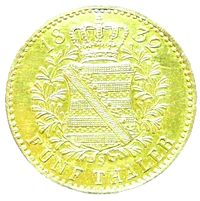Anton d'or
The Anton d'or is a gold coin that was minted during the reign of King Anton of Saxony from 1827 to 1836 in Albertine Saxony based on the model of Louis d'or and August d'or .
The legal basis is the edict of August 13, 1772 in accordance with the mint dict of May 14, 1763. King Friedrich August I of Saxony had already had the August d'or in the Dresden mint since 1806 according to the monetary standard of Louis d'or Have 21 carat 8 grän fine gold = 902.778 ‰ minted.
| Louis d'or | 35 pieces from the rough marrow | Fine weight = 6.032 g rough weight = 6.682 g | Value = 4 thalers 20 groschen to 5 thalers |
| Double Louis d'or | 17 ¼ pieces from the rough pulp | Fine weight = 12.065 g rough weight = 13.364 g | Value = 9 thalers 16 groschen to 10 thalers |
The minting took place in the Dresden mint in smaller numbers from 1827 to 1836:
- 5 thalers = 6,190 pieces
- 10 thalers = 43,700 pieces
| Anton d'or (5 thalers) 1832 | ||
| Anton King of Saxony (1827–1836) | ||
| Dresden Mint, minted 1829–1832, 3,605 in total | ||
| Mint master Johann Gotthelf Studer, term of office 1812 until March 29, 1832 | ||
| 1832: 175 pieces struck, 70 of which were struck in 1833 | ||
| Weight: 6.63g, diameter: 23.71mm, thickness: 1.11mm | ||
| Obv .: Head picture of the king to the right, name and title of ruler again with divine grace as inscription in German capital letters beginning from the left: ANTON VGG KOENIG VON SACHSEN | ||
| Rev .: Curved coat of arms under the royal crown with heraldically tinged majesty coat of arms from 1815, surrounded by two tied branches of the wall diamond; The year is separated from the crown as a transcription above, the lowercase S of the mint master's name between the ribbon below, the inscription below as the value: FÜNF THALER | ||
| Ring embossing, edge sticks on both sides with adjacent pearl circle, straight fluted edge, reverse embossing | ||
With the Vienna Mint Treaty of January 24, 1857, the further minting of gold coins other than the crown was prohibited. A suspension was not planned. The conversion rate was based on the gold price. The final suspension took place from April 1, 1874 in the value of 16.83 marks imperial currency for the August d'or and 33.66 marks imperial currency for the double August d'or.
Individual evidence
- ^ Stößel, Johann Christoph: Attempt at a Chur-Saxon coin history , Chemnitz 1780, p.903f. and 953
- ^ Arnold / Küthmann / Steinhilber: Grosser Deutscher Münzkatalog from 1800 to today , 29th edition 2014, p. 353f.
- ↑ Reichs-Gesetz-Blatt für das Kaiserthum Oesterreich, year 1857, XXIII. No. 101. from 06.06.1857, p. 373ff.
- ↑ Announcement regarding the suspension of state gold coins and foreign gold coins that are equivalent to domestic coins under state law from December 6, 1873, RGBl. P. 375.

